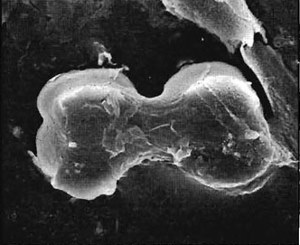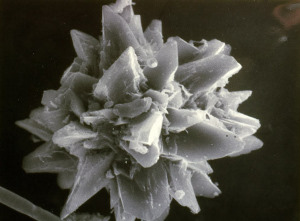Phytolith Analysis
Phytolith studies are important in reconstructing an approximate profile of vegetation present in local environments through time. In many plants, phytoliths are durable, microscopic bodies formed of silica absorbed through groundwater. Inside the plant, the silica deposits harden and form “copies” of the plant cells. Opal phytoliths, as they are called, have distinctive three-dimensional types of bodies that vary in size and shape according to plant and to the part of the plant in which it is present. In grasses, phytoliths exhibit diversity and distinctiveness according to grass species.
Because of their strength and resistance to decay over time, phytoliths preserve important information about plants at archeological sites, even though other portions of the plant may have rotted or been burned. The presence of certain phytoliths (e.g., panicoid, festucoid, and chloridoid) in the paleoenvironmental record can direct researchers to general vegetative conditions, such as forested habitats versus those of open grassland prairie. For example, the tall grasses of the Panicoideae subfamily are generally considered warm climate grasses. The Varga site phytolith assemblage reflects more of the grass component than the trees or other plant components. Phytoliths also represent grass communities that are not reflected in the pollen assemblage and thus add dimension to past environments
Twenty five paired pollen and phytolith soil samples were sent for analysis to Richard Holloway at Quaternary Services. Twenty of the paired samples were from a single column in Block A that included the entire deposit and captured all time periods. Five samples were from other dated sediments. (See Pollen Analysis for findings from that study.)
Methods
Phytoliths were isolated from soil samples using a conservative extraction technique involving screening, washing, and separation. Samples collected from the site were first screened through 1.6 mm (1/16th inch) mesh to remove larger materials. Five-gram sediment samples were placed in beakers and concentrated hydrochloric acid was added to remove carbonate materials. The residues were rinsed and consolidated and screened through very fine mesh to remove unwanted larger materials. A series of short centrifuge spins removed unwanted fine clays. The residues were washed with five percent potassium hydroxide to remove alkaline soluble humates and then rinsed until neutral.
Organic traces were removed by adding Schulze’s solution (concentrated Nitric Acid and Potassium Chlorate) and heating in a water bath for approximately 30 minutes to 1 hour. Following the removal of organic materials, the samples were rinsed until neutral and were fractionated in a water column. This procedure separated the phytoliths into 2 size fractions; fine and coarse fraction. This step is necessary as each fraction usually contains a unique set of phytolith types. Next, the samples were transferred to 15 ml tubes for heavy density fractionation. Zinc Bromide was added to the samples, which were centrifuged at high speed on a clinical centrifuge. Following this procedure, phytoliths floating on the heavy liquid were carefully pipetted off. The heavy density separation was repeated twice to ensure that a total phytolith recovery was made. Phytoliths were rinsed, dehydrated and curated in ethanol.
Permanent slides were prepared using Meltmount adhesive. The slide was routinely examined using 200X - 400X magnification, using Phase Contrast Microscopy, under an aus-Jena Laboval 4 compound microscope. Occasionally, phytoliths were examined using either 400X or 1,000X oil immersion to obtain a positive identification.
Findings of Phytolith Analysis
At the Varga site, phytoliths are much better preserved than pollen, as is often the case, and provide a greater insight of the past grassland communities. The phytolith assemblages show a dominance of Pooideae grasses (C3, or cool season) during the Early to Middle Archaic periods. Some C4 (warm season) type grasses were also present in the area during this early period, but contributed only limited numbers the assemblages. Over time there is a gradual increase in the proportions of C4 phytoliths during the Middle Archaic. The dominance of C4 types does not appear until the later portion of the Late Archaic or into the Toyah interval, as the region warmed and dried.
The Panicoideae and Chloridae grasses appear dominant in the Late Archaic and Toyah periods. These forms, often consisting of Saddle, Simple Lobate, Other Lobate, and Cross morphotypes, are generally associated with warm season (C4) type grasses. The cross type specifically occurs in a large number of the Panicoid grasses. The other cross shaped varieties continued through the later Toyah interval and are more likely related to the presence of Panicoid (C4) grasses in the area. Certainly, the higher percentages of C4 grass material indicates the introduction of these plants into the area during the Late Archaic and Toyah periods.
|
Phytolith analysis addresses such questions as:
|

|

